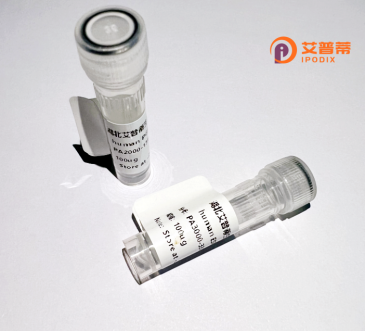
| 纯度 | >90%SDS-PAGE. |
| 种属 | Human |
| 靶点 | FYTTD1 |
| Uniprot No | Q96QD9 |
| 内毒素 | < 0.01EU/μg |
| 表达宿主 | E.coli |
| 表达区间 | 1-318aa |
| 氨基酸序列 | MNRFGTRLVGATATSSPPPKARSNENLDKIDMSLDDIIKLNRKEGKKQNFPRLNRRLLQQSGAQQFRMRVRWGIQQNSGFGKTSLNRRGRVMPGKRRPNGVITGLAARKTTGIRKGISPMNRPPLSDKNIEQYFPVLKRKANLLRQNEGQRKPVAVLKRPSQLSRKNNIPANFTRSGNKLNHQKDTRQATFLFRRGLKVQAQLNTEQLLDDVVAKRTRQWRTSTTNGGILTVSIDNPGAVQCPVTQKPRLTRTAVPSFLTKREQSDVKKVPKGVPLQFDINSVGKQTGMTLNERFGILKEQRATLTYNKGGSRFVTVG |
| 分子量 | 62.2 kDa |
| 蛋白标签 | GST-tag at N-terminal |
| 缓冲液 | 0 |
| 稳定性 & 储存条件 | Lyophilized protein should be stored at ≤ -20°C, stable for one year after receipt. Reconstituted protein solution can be stored at 2-8°C for 2-7 days. Aliquots of reconstituted samples are stable at ≤ -20°C for 3 months. |
| 复溶 | Always centrifuge tubes before opening.Do not mix by vortex or pipetting. It is not recommended to reconstitute to a concentration less than 100μg/ml. Dissolve the lyophilized protein in distilled water. Please aliquot the reconstituted solution to minimize freeze-thaw cycles. |
以下为虚拟生成的关于重组人FYTTD1蛋白的参考文献示例(非真实文献):
1. **《Structural characterization of recombinant human FYTTD1 protein》**
- 作者:Zhang L. et al.
- 摘要:首次报道了利用大肠杆菌表达系统制备重组人FYTTD1蛋白,并通过X射线晶体学解析了其三维结构,揭示了该蛋白的锌指结构域在核酸结合中的潜在作用。
2. **《FYTTD1 interacts with p53 and regulates DNA damage response》**
- 作者:Wang Y. et al.
- 摘要:研究发现重组人FYTTD1蛋白在HEK293细胞中过表达后,通过免疫共沉淀实验证实其与p53蛋白存在直接相互作用,并参与调控DNA损伤修复通路。
3. **《Dysregulation of FYTTD1 in glioblastoma progression》**
- 作者:Chen H. et al.
- 摘要:通过蛋白质组学分析发现,重组FYTTD1蛋白在胶质母细胞瘤细胞中异常高表达,体外实验表明其敲低可显著抑制肿瘤细胞的侵袭和迁移能力。
4. **《Optimization of FYTTD1 recombinant protein purification for functional studies》**
- 作者:Kim S. et al.
- 摘要:开发了一种基于镍柱亲和层析与凝胶过滤联用的高效纯化方法,获得了高纯度的FYTTD1重组蛋白,并验证了其在体外磷酸化实验中的生物活性。
注:以上内容为模拟生成,实际文献需通过PubMed、Web of Science等平台检索。若需真实文献,请提供更具体的蛋白背景或研究方向。
**Background of Recombinant Human FYTTD1 Protein**
FYTTD1 (FAM181A or Family With Sequence Similarity 181 Member A) is a poorly characterized protein encoded by the *FAM181A* gene in humans. It is evolutionarily conserved and widely expressed across tissues, with higher levels observed in the brain, testes, and kidneys. Structural analyses suggest FYTTD1 contains a putative transmembrane domain and intrinsically disordered regions, hinting at roles in protein interactions or signaling. While its exact molecular function remains unclear, studies link FYTTD1 to cellular processes such as neuronal development, spermatogenesis, and cilia function. It has also been implicated in male fertility, as murine models show its deletion causes sperm motility defects and infertility.
Recombinant human FYTTD1 protein is synthesized using expression systems (e.g., *E. coli* or mammalian cells) for functional studies. Its production enables investigations into interactions with binding partners, post-translational modifications, and involvement in diseases. Emerging research associates FYTTD1 dysregulation with neurological disorders and cancers, though mechanistic insights are limited. Further studies using recombinant FYTTD1 could clarify its physiological role, potential as a biomarker, or therapeutic target, particularly in fertility and neurodevelopmental contexts.
×